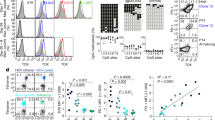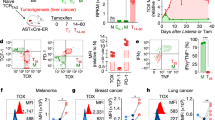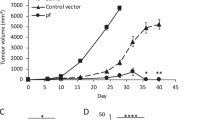Abstract
EFFECTOR T cells generated during the course of virus diseases of mice interact only with virus-infected target cells sharing H–2K or H–2D antigenic specificities with the mouse strain in which the lymphocytes are sensitised1–3. The current interpretation4 of this phenomenon is that the cell membrane component(s) recognised by the T-cell receptor(s) has characteristics of both self (H–2) and non-self (virus). Phenotypic expression of H–2 genes in the target cell would thus be essential for T cell-mediated immunity. Here we test this hypothesis using two teratocarcinoma cell lines (F–9 and PCC4 derived from strain 129 mice5,6) infected with lymphocytic choriomeningitis virus (LCMV). We show that the F–9 tumour cells apparently do not express H–2K or H–2D antigenic specificities (Fig. 1, Table 1), and are also resistant to attack by lymphocytes sensitised against LCMV. The PCC4 line, however, has remained multipotential and can give rise to various different cell types, at least some of which show evidence of H–2 gene function (Table 1) and are attacked by the appropriately sensitised lymphocytes.
This is a preview of subscription content, access via your institution
Access options
Subscribe to this journal
Receive 51 print issues and online access
$199.00 per year
only $3.90 per issue
Buy this article
- Purchase on Springer Link
- Instant access to full article PDF
Prices may be subject to local taxes which are calculated during checkout
Similar content being viewed by others
References
Doherty, P. C., Blanden, R. V. & Zinkernagel, R. M. Transplant. Rev. 29, 89–124 (1976).
Pfizenmaier, K., Starzinski, P. A., Rodt, H., Rollinghoff, M. & Wagner, H. J. exp. Med. 143, 999–1004 (1976).
Zinkernagel, R. M. Nature 261, 139–141 (1976).
Doherty, P. C., Götze, D., Trinchieri, G. & Zinkernagel, R. M. Immunogenetics 3, 517–524 (1976).
Bernstine, E. G., Hooper, M. L., Grandchamp, S. & Ephrussi, B. Proc. natn. Acad. Sci. U.S.A. 70, 3899–3903 (1973).
Jakob, H., Boon, T., Gaillard, J., Nicolas, J.-F. & Jacob, F. Ann. Microbiol. (Inst. Pasteur) 124 B, 269–282 (1973).
Gilden, D. H., Cole, G. A., Monjan, A. A. & Nathanson, N. J. exp. Med. 135, 860–873 (1972).
Germain, R. N., Dorf, M. E. & Benacerraf, B. J. exp. Med. 142, 1023–1028 (1975).
Schrader, J. W. & Edelman, G. M. J. exp. Med. 163, 601–614 (1975).
Forman, J. & Vitetta, E. S. Proc. natn. Acad. Sci. U.S.A. 72, 3661–3665 (1975).
Garrido, F., Schirrmacher, V. & Festenstein, H. Nature 259, 228–230; 261, 705–707 (1976).
Bevan, M. J. Nature 256, 419–421 (1975).
Blanden, R. V., Hapel, A. J. & Jackson, D. C. Immunochemistry 13, 179–191 (1976).
Vitetta, E., Artzt, K., Bennett, D., Boyse, E. A. & Jacob, F. Proc. natn. Acad. Sci. U.S.A. 72, 3215–3219 (1975).
Lafferty, K., Ryan, M. & Misko, I. J. Immun. Meth. 4, 263–273 (1974).
Zinkernagel, R. M. & Doherty, P. C. Scand. J. Immun. 3, 287–294 (1974).
Author information
Authors and Affiliations
Rights and permissions
About this article
Cite this article
DOHERTY, P., SOLTER, D. & KNOWLES, B. H–2 gene expression is required for T cell-mediated lysis of virus-infected target cells. Nature 266, 361–362 (1977). https://doi.org/10.1038/266361a0
Received:
Accepted:
Issue Date:
DOI: https://doi.org/10.1038/266361a0
This article is cited by
-
Resistance to 402AX teratocarcinoma involves immunity to minor histocompatibility antigens
Immunogenetics (1987)
-
Theimunopathogenesis of cronic HBV inducedliver disease
Springer Seminars in Immunopathology (1981)
-
Expression of H–2, laminin and SV40T and TASA on differentiation of transformed murine teratocarcinoma cells
Nature (1980)
-
Natural killer cells mediate lysis of embryonal carcinoma cells lacking MHC
Nature (1980)
-
Recognition of viral antigens in 6/94 virus-induced T-cell-mediated cytotoxicity
Medical Microbiology and Immunology (1979)
Comments
By submitting a comment you agree to abide by our Terms and Community Guidelines. If you find something abusive or that does not comply with our terms or guidelines please flag it as inappropriate.



